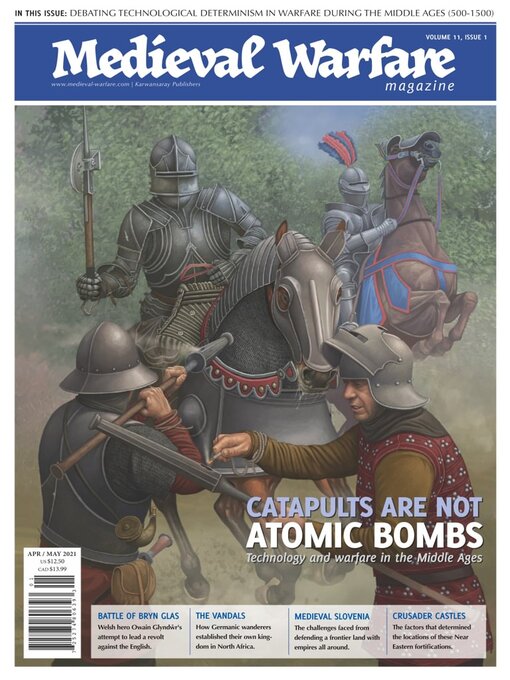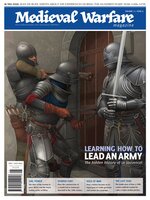Medieval Warfare picks up where its sister magazine, Ancient Warfare, leaves off. Starting around 500 AD, Medieval Warfare examines the world during the Middle Ages up through the early years of the Renaissance (the magazine generally leaves off in the 16th century). While popular topics such as the Crusades and the Vikings are given regular coverage, Medieval Warfare also tackles more complex and obscure topics, ranging from the Umayyad Caliphate versus the Byzantine Empire to horse trading in 14th-century England.
Marginalia
THE BATTLE OF BRYN GLAS, 1402 • On St. Alban’s Day, 22 June 1402, in a quiet valley on the borders of Wales, an outnumbered rebel force under the leadership of Owain Glyndwr destroyed an English army under the control of Sir Edmund Mortimer, one of the most powerful lords of England.
THE HUNDRED-YEAR KINGDOM • A century passed between the Vandals’ conquest of North Africa and their defeat by Byzantium. During this time, they became a major military power and withstood repeated Roman invasion attempts. In the end, however, the Vandal experiment succumbed to the overwhelming resources and prowess of the Empire.
THE MOUNTED CROSSBOWMAN • While works on mounted soldiers tend to focus on heavy cavalry, in this article we turn to the mounted crossbowman. They were active in a fairly wide arena, from Italy to the British Isles in the north, and in some of the most powerful states such as France. Moreover, they operated for a rather long period of time, from at least the twelfth century to the sixteenth century.
FROM STIRRUPS TO LONGBOWS • For decades historians have been debating the role of technology in warfare. Here we explore some of the issues related to technological determinism, using the Middle Ages as a lens.
Six laws of technology
CATAPULTS ARE STILL NOT ATOMIC BOMBS • Twenty years ago, War in History published my methodological article, “Catapults are Not Atomic Bombs: Towards a Redefinition of ‘Effectiveness’ in Premodern Military Technology”. The title was purposeful hyperbole: I mention neither catapults nor atomic bombs elsewhere in the article. Also purposeful, although less hyperbolic, was my initial example of a modern military technology that continued to be (and still is) lethal, the land mine – writing today I might use the improvised explosive device (IED) or drone – but would never be looked at as premodern military technology is: ‘decisive’, ‘invincible’, or ‘revolutionary’. Rather it is a question as to how we might define the ‘effectiveness’ of this technology.
A TRANSFORMATIVE TECHNOLOGY THAT WASN’T • Sometimes there is a story that’s just so simple and explanatory that it just must be true … even when it isn’t. Such is the so-called ‘Stirrup Thesis’ most tightly connected to a story that Lynn White, Jr. told in his 1962 book, Medieval Technology and Social Change, which has been one of the few medieval history textbooks to remain continuously in print since its publication.
White’s view of technology
ENGLAND’S HOME AWAY FROM HOME • On 26 August 1346, an English army led by Edward III decisively defeated a numerically superior French force led by Philip VI at the Battle of Crécy. This unexpected triumph against the odds was England’s first major success during the Hundred Years’ War. Edward exploited his victory by advancing to lay siege to the coastal town of Calais. Its capture would make it far more convenient and safer for English armies to invade northern France. Yet the siege of Calais proved to be a long and difficult enterprise.
ASTRAL MAGIC AND WARFARE • Those who could understand the secret knowledge of the planets and cosmos could could achieve advantages in warfare with supernatural technology. The key to this power was told in the Picatrix.
When you wish to pray to Mars
NEITHER CATAPULTS NOR ATOMIC BOMBS •...

 Issue 11 - 2024
Issue 11 - 2024
 Issue 10 - 2024
Issue 10 - 2024
 Issue 9 - 2023
Issue 9 - 2023
 Issue 8 - 2023
Issue 8 - 2023
 Issue 7 - 2023
Issue 7 - 2023
 Issue 6 - 2023
Issue 6 - 2023
 Issue 5 - 2023
Issue 5 - 2023
 Issue 4 - 2022
Issue 4 - 2022
 Issue 3 - 2022
Issue 3 - 2022
 Issue 2 - 2022
Issue 2 - 2022
 Issue 1 - 2022
Issue 1 - 2022
 MW X11.1
MW X11.1
 MW X1.5
MW X1.5
 MW X1.4
MW X1.4
 MW X1.3
MW X1.3
 MW X1.2
MW X1.2
 MW X1.1
MW X1.1
